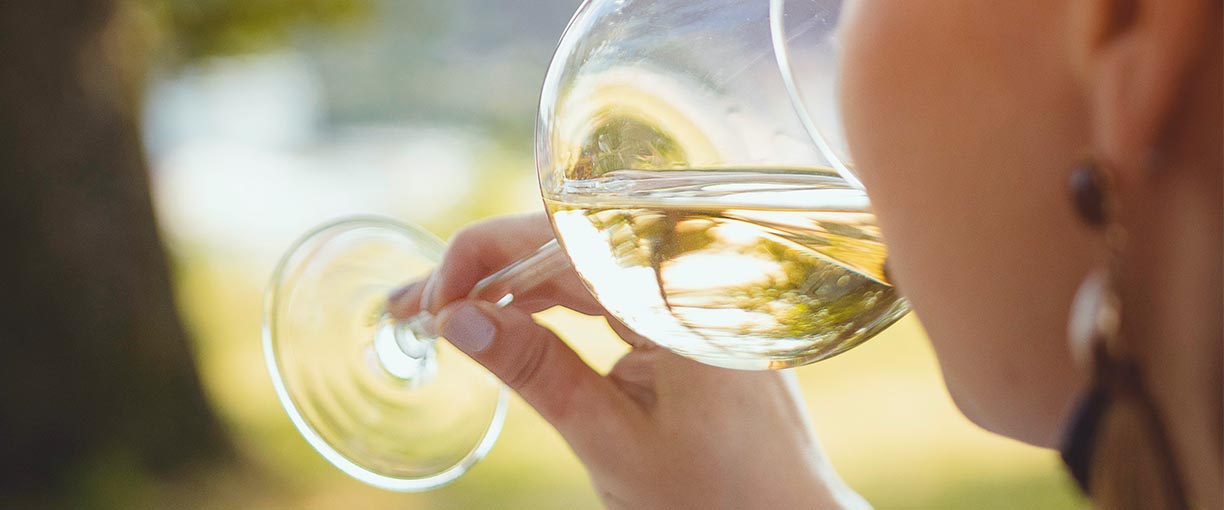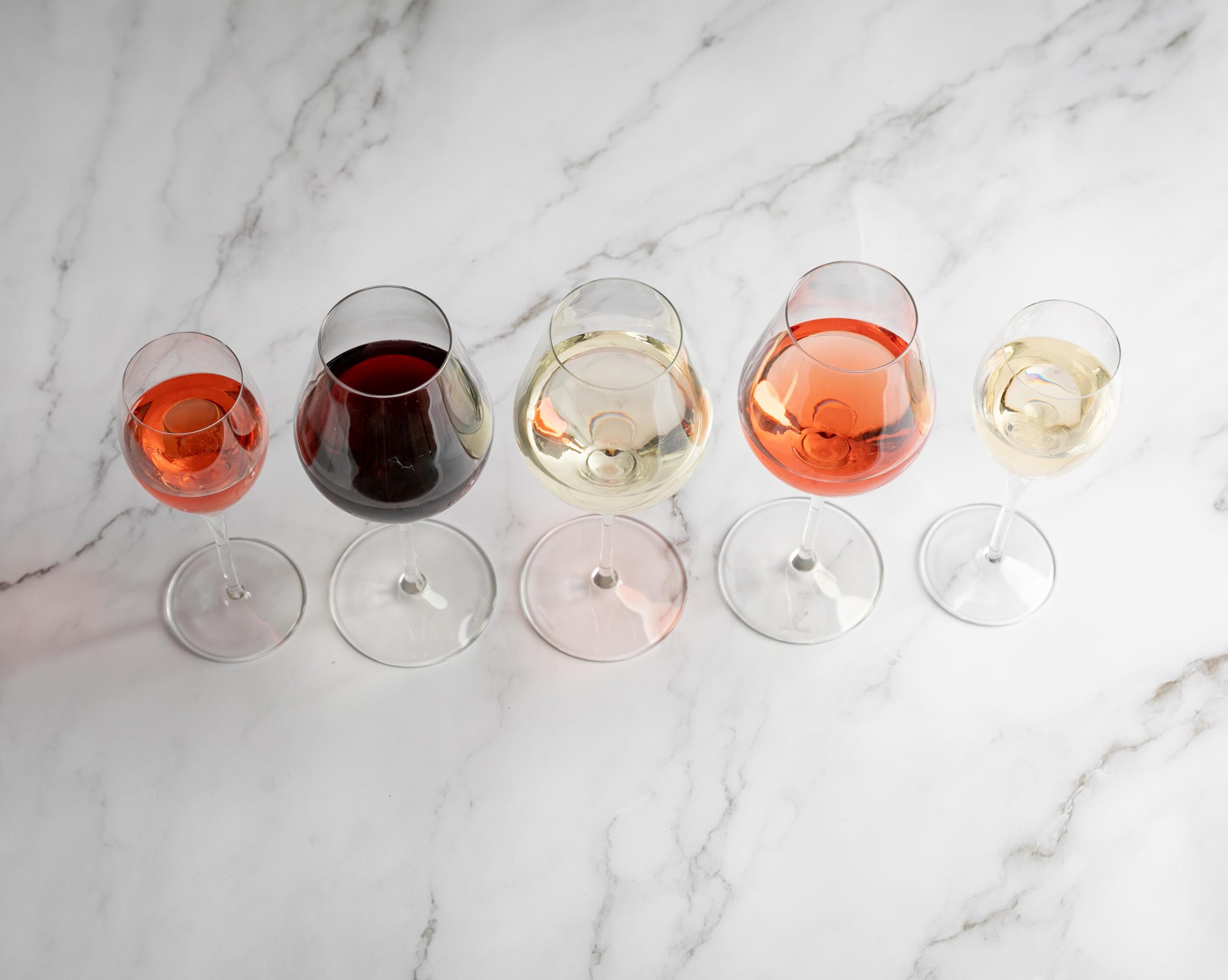Before you begin with your wine tasting, make sure to give yourself the best chance of tasting the wine properly. The conditions have to be right; If they are it will also be a more enjoyable experience. So be sure to move away from any strong smells, noises or heat. Also, make sure you have the right glass for the job. Take white wines from the fridge or cooler about a quarter of an hour before tasting them. And for red wines, ensure they are just below room temperature – you can also warm them in your hands by cupping the bowl of the glass, (which is one reason why red wine glasses tend to have larger bowls than white wine glasses).
The proper way to taste wine is to be aware of the various elements that make up the wine. Think of its main characteristics – look at the colours, which will tell you a lot about the wine, such as age and strength. Then think, is it sweet or dry and floral, fruity or indeed something else? Crisp or smooth? These will come through while sniffing and tasting. If you’re just starting out on your journey into the world of wine, this may feel a bit overwhelming.
How does a wine taste for beginners? At first you might think it’s just sweet, or sour, or fruity – and that’s fine. With experience – and our wine tasting tips – you’ll learn to develop these basic observations and the wines will reveal themselves more and more to you. The best way to approach wine tasting is by using the 5 main points.
What are the five main points?
These are the five main ways of structuring your wine tasting – make sure to do them all, because enjoying wine is a treat for all your senses – not just your taste buds! Next time someone asks you ‘how does wine taste’, you’ll know that the answer lies in the following elements.
1. See
You’d be surprised by how much you can tell about a wine just by inspecting it. A deeper, more intense colour, whether that’s white or red, can indicate how strong the wine’s flavour may be. It can also indicate a wine’s age. White wines gain darker hues as they age, while red wines actually lose their colour over time.
Looking at the wine before you drink it helps you check if there’s any sediment. Sediment is normal with red wines. If you notice any, you just need to allow it time to settle at the bottom of the bottle and pour carefully to avoid getting any in the glass.
2. Swirl
Swirling wine in its glass before you taste it is an important part of the tasting process. It adds oxygen to the wine, allowing the flavours to open up and aromas to rise, catching on the lip of the glass – which will help with the next step.
Sometimes, you may notice that the wine stays a while on the sides of the glass. This is referred to as “legs” or the “tears” of the wine and indicates its viscosity. A more pronounced viscosity generally translates to a more rounded mouthfeel.
3. Smell
After you’ve swirled the wine, allowing its aromas to rise, it’s time to smell by putting your nose right into the glass (without touching the wine!).
You might smell vegetation, wood, minerals, and even smoke or wet stones. These exist in wine aromas because of the rich array of flavour elements. It’s normal to detect unusual aromas. A wine’s smell can also change once it’s in contact with air.
4. Sip
The main event! The steps before should have given you a good feeling for the wine and how it may taste. To properly taste wine, try to let some air in while sipping and hold it in your mouth for 3-5 seconds. To get technical, there are three types of flavour to look out for:
Primary: These are the most dominant aromas and come from the grapes themselves. They could be fruity, floral, spicy, or anything in between.
Secondary: Secondary flavours come from the fermentation process, or the actual barrel that the wine was put in, so are often oaky, for example.
Tertiary: The tertiary flavours can become more complex as time goes on because they occur through the ageing process. Again, you may notice odd flavours here, which is perfectly normal.
5. Savour
The final step is to “finish” your taste of wine. No matter if you swallow it or use a spittoon or a bucket, you’ll notice how the flavours linger on your palate. You may notice a powerful finish, where new flavours develop, or there might be a nice acidity which has a cleansing effect. Take time to savour the flavours and see what you notice.
How to Describe the Taste of Wine
Wines come in a variety of styles and flavours, from red to white, still and sparkling. As such, there are a variety of ways to describe the taste.
Every wine has a structure. Some will contain more tannins than others – tannins are natural compounds that are found in the skins, stems, and seeds of a grape. Wines with greater tannin content will make your mouth feel a little drier, while a lower tannin content can contribute to the sweetness of the wine. Others are acidic or creamy.
Common Wine Tasting Terms Associated With Taste and What They Mean
Acidity: When you taste your wine, you may notice a tingling sensation around the back of your throat which makes your mouth water. This is caused by acids which are added to wine to sharpen its taste. The longer your mouth waters, the more acidic the wine is.
Balanced: A balanced wine is one in which the fruit, alcohol, and acidity work harmoniously together, with no one element standing out over another.
Body: The “fullness” of wine and how it feels in the mouth is described as its body. So, full-bodied wines are rich in taste and often much higher in alcohol content, while wines with a lighter body feel much more delicate in the mouth.
Bold: Bold wines are often fruity and particularly striking in flavour. The opposite of this is an “elegant” wine, one that is more understated in taste.
Bouquet: This is another way of describing the aroma of a wine – its smell, essentially. Common bouquets described when tasting wine include fruit, flowers, herbs, earth, grass, tobacco, and chocolate.
Complex: This term is used to describe wine that changes its flavour noticeably from first taste to aftertaste.
Finish: The finish is how long the taste of the wine lasts in your mouth after swallowing (or spitting it). Generally, the longer the taste lasts, the higher the quality of the wine.
Minerally: Wines that are neither fruity, herby, or spicy are described as “minerally”. They may have an almost metallic taste with a noticeable tang.
Oaky: Oak has a huge influence on a wine’s flavour, second only to the actual grape variety. A wine that’s aged in oak barrels will have an oaky taste. For white wine, this might taste like vanilla and butter, while in red wines it could be more smokey. Wines without oakiness have a tendency to have lemony notes.
Zesty: A “zesty” wine is one of noticeable citrus notes and acidity.
How to Taste Red Wine
When tasting red wine, remember that its naturally higher tannin content may make it feel drier in your mouth. Red wine should be served just under room temperature, so around 16 °C. This allows the tannins to smooth out. Some red wines, like the Pinot Noir, can actually benefit from being a little cooler at 14 °C.
Pour red wine into a glass with a wider opening. This allows ethanol to evaporate and tannins to soften, allowing for an even smoother drinking experience.
How to Taste White Wine
White wines are best enjoyed at cooler temperatures of 8-10°C. A standard fridge is colder than this, so make sure to take white wine out and let it warm for a few minutes before you taste it.
To get the most out of tasting white wine, serve it in a glass with a smaller bowl. Doing so helps elevate the wine’s aromas while also preserving fruity, floral notes as the wine will be closer to the nose.
Why Do People Spit Out Wine at Tastings?
There are a few reasons for spitting out wine when tasting. As you get more intoxicated, you’re less able to detect subtle nuances in flavours and aroma, as your palate gets overwhelmed with alcohol and your senses dulled. A wine tasting event might mean sampling up to 40 or more wines, so spitting is the only realistic way to sample them all.
Sometimes, swallowing the wine does give a better overall experience because it reaches the taste buds at the very back of your mouth. And when you exhale, you get even more flavour.
We hope that these wine tasting tips have given you some ideas of things to try next time you are tasting good wines with friends, and a deeper understanding of how to taste wine.
For more hints and tips visit our blog page. Ready to try out award-winning wines? View our range here.
Book the Ultimate Wine Tasting Experience With Bolney Wine Estate
Want to see how the professionals conduct a wine tasting? Visit Bolney Wine Estate’s 50-year-old vineyard in the heart of the Sussex countryside for the ultimate wine sampling experience. You’ll get a dedicated Bolney guide taking you through a fully tutored tasting of some of our award-winning wines, showing you exactly how it’s done.
Browse our full list of wine-tasting experiences and discover the journey from vine to wine on an immersive day that satisfies all the senses.

A beginner’s guide to food and wine pairing
If you’re curious about what you eat and drink, then you might find yourself wondering what to drink with your favourite meals. We’ve created this article which includes our favourite tips and recommendations to create a helpful guide for anyone wanting to pair good wine and food.

 Account
Account




 Back
Back




